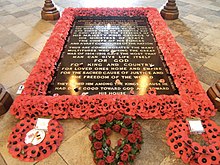David Railton
David Railton | |
|---|---|
Clergyman, Military chaplain | |
| Spouse | Ruby Marion Wilson[1] |
| Children | One son and four daughters, including Dame Ruth Railton |
| Parent(s) | George Scott Railton Marianne Deborah Lydia Ellen Parkyn |
Early life
Railton was the son of
World War I
In 1910, he moved to Ashford, Kent, and in the following year became temporary chaplain to the Forces. He was curate of Folkestone in 1914–20, but had leave of absence to serve in France. He was awarded the Military Cross in 1916 for saving an officer and two men under heavy fire.[2]
Railton first had the idea of arranging for the body of an unknown serviceman to be transported back to England, and buried with full honours, in 1916, while he was serving on the Western Front during World War I.
Later in the war he wrote to Lord Douglas Haig expressing this idea. He received no response, but felt reluctant to let it go.[6]
The Unknown Warrior

After the War Railton became the vicar of St. John the Baptist Church at
In October 1920 Railton heard that his idea had been accepted by the Government. A committee headed by
At midnight one of these coffins was chosen by
In 1916 Railton was an experienced and mature man in his thirties and was appalled at the sufferings and loss caused by the War. He later tried to explain why he had felt it was so important to commemorate the individual in this way. He recalled an incident near Armentières where he came across a grave with a rough wooden cross inscribed "An unknown British soldier, of the Black Watch":
How that grave caused me to think!... But, who was he, and who were they [his folk]?... Was he just a laddie... . There was no answer to those questions, nor has there ever been yet. So I thought and thought and wrestled in thought. What can I do to ease the pain of father, mother, brother, sister, sweetheart, wife and friend? Quietly and gradually there came out of the mist of thought this answer clear and strong, "Let this body – this symbol of him – be carried reverently over the sea to his native land". And I was happy for about five or ten minutes.[6]
Later years
After the war Railton returned briefly to Folkestone before being successively vicar of St John the Baptist, Margate (1920–25), curate of Christ Church, Westminster, vicar of St James's, Bolton, Bradford, Yorkshire, vicar of Shalford, near Guildford (1931–35), rector of St Nicholas's, Liverpool, and archbishop's visitor to the RAF (1943–45) before his retirement in 1945.
In addition, he worked with the Revd

References
- ^ Lundy, Darryl. "p. 27449 § 274483". The Peerage.[unreliable source]. Accessed 4 August 2011.
- ^ doi:10.1093/ref:odnb/74777. (Subscription or UK public library membershiprequired.)
- ^ Railton on the Salvation Army International Heritage Centre website
- ISBN 9781594672064.
- ISBN 9780850330489.
- ^ a b c The Unknown Warrior: 'Unknown and yet well known' Compiled by Mary P. Wilkinson, (2000) Imperial War Museum, London
- ISBN 0-9524464-4-8.
- ^ Obituary, 1 July 1955.
- ^ Register of Deaths – 9 August 1955 Fort William
Further reading
- Richards, Andrew (2017). The Flag: the story of Revd David Railton MC and the Tomb of the Unknown Warrior. Oxford: Casemate. ISBN 978-1-61200-447-1.
External links
- 'Flying the flag for the Padre once more'[dead link] The Daily Telegraph 2006-11-10
- Railton in the Oxford Dictionary of National Biography
- Railton and the Unknown Warrior
- Railton's papers in the collection of the Imperial War Museum
- Lundy, Darryl. "Railton". The Peerage.[unreliable source]
